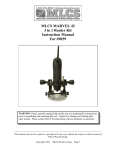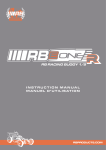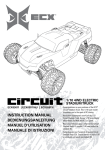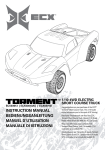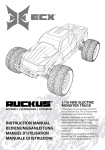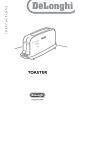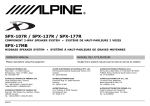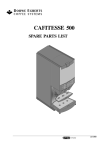Download MLCS Rocky 30 9056 Instruction manual
Transcript
MLCS Rocky 30
Trim Router
Instruction Manual
For #9056
WARNING: Please read this manual fully and be sure you understand its instructions
prior to assembling and operating this tool. Inspect for damage and missing parts
upon receipt. Please contact MLCS Woodworking with any problems or questions.
-------------------------------------------------------------------------------------------------------------------This manual may not be copied or reproduced in any way without the express written consent of
MLCS Woodworking.
Copyright 2014. MLCS Woodworking. Page 1
TABLE OF CONTENTS
SECTION 1: Technical Data………………………….…..2
SECTION 2: General Instructions…………………….….3-5
SECTION 3: Unpacking & Checking Contents..………..6
SECTION 4: Assembly, Adjustments & Operations…....7-13
SECTION 5: Maintenance..…………………………….…14
SECTION 6: Exploded Diagram & Parts List……………15-16
TECHNICAL DATA
Item number/name……………………………..9056/Rocky 30
Motor…………………………………120 Volts, 60 HZ, 6 Amps
Rated power..……………………………………………..…1 hp
No load speed………………………….. 10,000 - 30,000 RPM
Bit shank diameter…………………………………..1/4” or 3/8”
NOTE: If using an extension cord while operating this tool, observe the minimum gauge
requirement as shown in the chart below. Use only UL listed extension cord.
Gauge Total Extension Cord Length in Feet
16
25 feet
14
25, 50 feet
12
25, 50, 100 feet
-------------------------------------------------------------------------------------------------------------------This manual may not be copied or reproduced in any way without the express written consent of
MLCS Woodworking.
Copyright 2014. MLCS Woodworking. Page 2
General Instructions for 110V Routers
WARNING!!
KEEP TOOLS AND EQUIPMENT OUT OF THE REACH OF YOUNG CHILDREN!!
Good Working Practices/Safety
The following suggestions will enable you to observe good working practices, keep yourself and
fellow workers safe and maintain your tools and equipment in good working order.
Primary Precautions
This tool is supplied with a molded 15 Amp Plug and polarized 2 wire power cable. Before
using the tool, inspect the cable and the plug to make sure that neither is damaged. If any
damage is visible have the tool inspected/repaired by a suitably qualified person. If it is
necessary to replace the plug, it is preferable to use an 'unbreakable' type that will resist damage
on site. Only use a 15 Amp plug. Make sure the cable clamp is tightened securely. If extension
cords are to be used, carry out the same safety checks on them, and ensure that they are correctly
rated to safely supply the current that is required for your machine.
Workplace/Environment
Do not carry the router with a cutter installed and protruding below the base.
The router is not designed for use in any situation where it may get wet. If router is set
up in the open and it starts to rain, cover it up or move it into a dry area. If the router has
gotten wet, dry it off as soon as possible with a cloth or paper towel. Do not use ACpowered machines anywhere within a site area that is flooded or anywhere liquid is
puddled, and do not trail extension cords across wet areas. Clean the router with a damp
soapy cloth if needed. Do not use any solvents or cleaners, as these may cause damage
to the plastic parts or to the electrical components.
Keep the work area as uncluttered as possible. This includes personnel as well as
material. Under no circumstances should CHILDREN be allowed in work areas.
It is good practice to leave the router unplugged until work is about to begin. Make sure
to unplug the machine when it is not in use or unattended. Always disconnect by pulling
on the plug body and not the cord. Once you are ready to begin working, install the
cutter and remove all tools used in the installation operations (if any) and place them
safely out of the way.
-------------------------------------------------------------------------------------------------------------------This manual may not be copied or reproduced in any way without the express written consent of
MLCS Woodworking.
Copyright 2014. MLCS Woodworking. Page 3
Clamp the work-piece to a stable work surface. Check to make sure that the “cutting
path”' is unobstructed, and observe the old woodworkers' adage of “never placing your
hands closer than one hand’s length to the cutting tool”. Do not attempt to machine any
small pieces or work any material that cannot be held securely in a clamp.
Make sure you are in a comfortable stance before you start to work, balanced, not
reaching etc.
If the work you are carrying out is liable to generate flying dust or chips, wear the
appropriate safety clothing, goggles, gloves, masks etc. If the work operation appears to
be excessively noisy, wear ear protection. If you wear your hair in a long style, wearing a
hat, cap, or safety helmet will minimize the possibility of your hair being caught up in the
rotating parts of the tool. Likewise, consideration should be given to the removal of rings
and wristwatches, since these are liable to be a 'snag' hazard.
Do not work with cutting tools of any kind if you are tired or if you are being subjected to
distraction.
Do not use power tools within the designated safety areas where flammable liquids are
stored or in areas where there may be flammable gases present.
Check that your cutting bits are undamaged and are kept clean and sharp, this will
maintain their optimal operating performance and lessen the loading on the tool.
Above all, BE OBSERVANT. Make sure you know what is happening around you, and
USE COMMON SENSE.
-------------------------------------------------------------------------------------------------------------------This manual may not be copied or reproduced in any way without the express written consent of
MLCS Woodworking.
Copyright 2014. MLCS Woodworking. Page 4
Additional Safety instructions for use of Routers
1. Make sure you have read and fully understood the General instructions and safety precautions
that are printed in the preceding pages of this manual.
2. Before connecting the router to the power supply, check the tool for obvious signs of damage,
paying particular attention to the plug and the power cord. Correct any damage you discover.
Be sure the router bit you are about to fit is the correct tool for the job. Check the bit for damage,
make sure it is sharp and clean, check that you have the correct collet for the tool shank size you
are about to fit, and ensure that a sufficient length of the shank is inserted in the collet to
guarantee a secure hold of the bit. Make sure the tools you use to fit the router bit, or the
accessories, are the correct ones. DO NOT risk damaging the tool by using the wrong size collet
wrenches, allen keys, etc. Make sure the 'chip screens' (if available) are fitted securely. If dust
extraction is available, connect it.
3. Check that there are no foreign objects, e.g. old nails, screws, small stones etc., embedded in
the work-piece.
4. Set the depth of cut, either as a single depth or incrementally (for deep cuts). Install and set
the guide fence if required.
5. Ensure the machine is switched off. ('0' showing) (Never turn on the power unless you are
actually holding the machine). Plug the power cord into a correctly rated switched outlet. If you
are working outside, check that any extension cords in use are rated for outside work.
6. Make sure you are holding the machine in a safe position, the cutter bit is not in contact with
anything, and the 'cutting depth' is locked. Give the machine a quick "burst", to ensure that
everything is working correctly, checking especially for vibration that might indicate that the
cutter is incorrectly installed. If a vibration is present, disconnect the machine, re-install the
cutter, and test again.
8. Make sure that the power cord is safely routed away from the operating area, and that the
router movement during the operation will not drag it within range of the cutter.
-------------------------------------------------------------------------------------------------------------------This manual may not be copied or reproduced in any way without the express written consent of
MLCS Woodworking.
Copyright 2014. MLCS Woodworking. Page 5
Unpacking and Checking Contents
1. To avoid injury from unexpected starting or electrical shock, do not plug the power cord into a
source of power. This cord must remain unplugged whenever you are servicing and assembling
this router.
2. When unpacking and checking contents, separate all loose parts from packaging material and
check each item to make sure all items are accounted for before discarding any packing material.
If any parts are missing, do not attempt to use this router, plug in the power cord, or turn the
switch on until missing parts are obtained and are installed correctly.
-------------------------------------------------------------------------------------------------------------------This manual may not be copied or reproduced in any way without the express written consent of
MLCS Woodworking.
Copyright 2014. MLCS Woodworking. Page 6
Assembly and Adjustments
This tool is designed to be used strictly as a router/edge trimmer.
Caution! Do not use this tool for drilling holes. It is not intended to be used as a drill.
This tool is equipped with the following electronic functions:
Constant Speed Control: Electronic circuit allows the motor to maintain a constant speed,
even under full load conditions.
Soft Start: This feature minimizes start up “torque twisting” by allowing the motor to
gradually come up to speed.
ON/OFF SWITCH:
The power switch is located on the side of the top cover of the motor housing. Pushing the rocker
switch to the “I” position turns on the power. Pushing the rocker switch to the “0” position
interrupts the power and turns the tool off.
WARNING! Never use the tool if its switch cannot turn it on or off smoothly.
WARNING! Never use tool without the motor installed in the router base.
VRIABLE SPEED DIAL:
The Rocky 30 has a variable speed control to correctly match the router bit speed to the type of
bit and material that is being used. There is dial on the top of the motor housing to change the
speed. The speed is selected by rotating the variable speed dial between the lowest setting (1),
and the highest setting (6). Refer to the following chart for choosing your desired speed:
Number
1
2
3
4
5
6
Speed
10,000 rpm (Minimum)
12,000 rpm
17,000 rpm
22,000 rpm
27,000 rpm
30,000 rpm (Maximum)
-------------------------------------------------------------------------------------------------------------------This manual may not be copied or reproduced in any way without the express written consent of
MLCS Woodworking.
Copyright 2014. MLCS Woodworking. Page 7
Installing and Using the Accessory Dust Port:
The Rocky 30 is supplied with a dust extraction port. It is designed to snap into the base and
allow you to hook it up to a vacuum source to remove the dust and chips that are created during
the routing operation. The dust port has a pin on the inside near the extraction port that fits into
the hole in the base. The dust port is secured to the base with the small thumbscrew which
threads into the base on the opposite side of the port as shown in the diagram below.
-------------------------------------------------------------------------------------------------------------------This manual may not be copied or reproduced in any way without the express written consent of
MLCS Woodworking.
Copyright 2014. MLCS Woodworking. Page 8
Adjusting the Router Motor Height:
The Rocky 30 uses a rack and pinion gear on the router base to adjust the motor height. The gear
on the base engages the teeth that are machined in the face of the router motor. Make sure that
you do not attempt to adjust the motor height while the router is running. The motor must be
turned off and the power cord should be unplugged from the power source to prevent the router
motor from inadvertently being turned on. Start by loosening the locking flip lever to loosen the
motor in the base. Turn the height adjustment knob in the direction you need to raise or lower the
motor to the desired height for the cut depth you would like. When you are satisfied with the
motor position, re-engage the locking mechanism by flipping the locking lever to the locked
position. The router has a convenient scale to assist when making your height adjustments.
If you are unable to keep the motor secured with the locking lever in the locked position, tighten
the hex nut (6) behind the locking lever to apply more tension on the lever. Test and readjust as
needed until the router motor stays securely locked in position.
Changing Collet Inserts:
The Rocky 30 is supplied with both 1/4” and 3/8” collet inserts. To change the collet insert,
loosen and remove the collet nut and insert the desired collet for the bit you intend to install in
the router. Replace the collet nut but do not tighten it fully unless there is a router bit inserted
into the collet as it is possible to permanently distort the collet insert doing this. This could make
inserting bits into the collet difficult or cause you to need to replace the collet insert.
-------------------------------------------------------------------------------------------------------------------This manual may not be copied or reproduced in any way without the express written consent of
MLCS Woodworking.
Copyright 2014. MLCS Woodworking. Page 9
Inserting A Router Bit into the Collet:
With the collet nut loose, slide the router bit into the collet insert. Make sure that you have at
least 3/4” of the router bit shank inserted into the collet. Do not bottom out the bit in the collet. If
you insert the shank to the bottom of the collet bore, make sure to pull it out at least 1/16” to 1/8”
to allow the collet insert to properly secure the router bit in the collet. There is a button on the
motor housing that will lock the spindle to allow you to tighten and loosen the collet nut using
the supplied wrench. It will be necessary for the spindle to rotate until the spindle lock pin
engages the locking hole on the spindle. Before tightening the bit, make sure the flutes of the bit
are completely visible outside the collet. Otherwise, it can result in broken bits and possible
injury. The power cord should be unplugged from the power source when making bit changes to
prevent the router from being turned on by accident.
WARNING! Never use dull or damaged bits. Damaged bits can break without warning.
Dull bits may overload the motor, cut slowly and are difficult to control. They will also
overheat and possibly break.
Operations
1. Before operation:
1) Before turning the tool ON, check to make sure the router bit and any fasteners used to
attach accessories are properly tightened.
2) Avoid cutting your fingers. Make sure all of your fingers are far back from the workpiece before operation. Keep your hand far away from moving parts.
3) Before starting the tool, make sure that the bit does not touch the work piece.
4) Before cutting the work-piece, let the tool turn for a while without load.
2. During operation:
1) Always hold the tool with two hands during start-up and operation.
2) Always make sure the work- piece is free of nails and other foreign objects. If the bit
strikes a nail it will jump sideways and possibly break.
-------------------------------------------------------------------------------------------------------------------This manual may not be copied or reproduced in any way without the express written consent of
MLCS Woodworking.
Copyright 2014. MLCS Woodworking. Page 10
3. After operation:
1) When the cut is complete, turn the tool OFF, wait until it comes to a complete stop and
remove it from the work-piece.
2) Never lay the tool down until the tool comes to a complete stop. A spinning bit can come
in contact with the ground surface and the workbench and pull it out of your control.
3) Never touch the bit immediately after use. The bit may be too hot to be handled with
your hand and may burn your fingers.
4. Working procedure:
Before attempting to work on an actual project, make a few practice cuts on some
scraps of material. Use the same type of material you will be using in your actual
project to see how the cutters will work. After making the test cut, make any
necessary adjustments to the cutting depth, motor speed or feed rate to achieve the
best results.
Freehand Routing:
Use the router base with small router bits to perform various freehand routing projects.
Insert the appropriate size collet (1/4 or 3/8) for the router bit you will be using. Install the router
bit and securely tighten it. Adjust the router base height to the correct routing depth. Before
turning the switch ON, make sure the router bit is not in contact with anything. Holding the two
height adjusting knobs with both hands, carefully lower the bit onto the work-piece and guide the
bit around the stock in a clockwise direction.
Cutting a Straight Line with a Straight Edge Guide:
To cut a straight line, you can use a straight edge template to guide the router base. Draw a
straight line on the work-piece where you wish to make the cut. Draw a second straight line
parallel to the cut line back into the work-piece at the distance between the router base and
-------------------------------------------------------------------------------------------------------------------This manual may not be copied or reproduced in any way without the express written consent of
MLCS Woodworking.
Copyright 2014. MLCS Woodworking. Page 11
the router bit (A). Clamp the straight edge guide onto the stock at the secondary line. Place the
router base against the straight edge with the bit near the start of the cutting line. Turn the switch
ON while firmly holding the tool. Slide the router plate against the straight edge while making
the cut.
Cutting Curved Line with a Template:
To cut a curved line, you can use a curved template to guide the router base. Make a template
from hard board or other similar material to the shape you required. Note: Radius of curve must
be greater than 2 1/2" for router base to properly follow the curved template. Mark the location
of the cut to be made. Mark the work-piece approximately 2 1/16" back into the work-piece
(away from the cutting line). Clamp or use double sided tape to secure the template onto the
work-piece that is to be cut. Place the router base against the template with the bit near the start
of the cutting line.
Installing and Using the Straight Edge Guide:
The edge guide is used for making straight cuts, grooves or following an edge with a bit that
does not have a guide bearing. Attach the guide plate to the straight guide with the bolt and wing
nut. Make sure to position the straight guide with the guide fence positioned downward as shown
in the diagram. Secure the straight edge guide to the router base using the clamping screw on the
router base. Loosen the wing nut on the straight edge guide and adjust the distance between the
router bit and the straight guide to the desired position. Tighten the wing nut to secure the
straight edge guide at the correct distance. When making the cut, move the router with the
straight guide firmly against the edge of your stock. If the desired location of the cut is greater
than the capacity of the straight edge guide, refer to the previous page for the instructions
“Cutting a Straight Line using a Straight Edge Guide”.
-------------------------------------------------------------------------------------------------------------------This manual may not be copied or reproduced in any way without the express written consent of
MLCS Woodworking.
Copyright 2014. MLCS Woodworking. Page 12
Making a Circle Cut:
Cutting circles between a minimum radius of 2-3/4” and maximum radius of 6-11/16” can be
accomplished with the straight edge guide. You have to assemble the guide as shown with the
straight edge positioned upward, and use a nail to act as a pivot pin for the guide to rotate
around. Adjust the size of the circle and lock in place using the wing nut.
Using the Trimmer Guide:
Trimming thin stock or veneers can be accomplished with a 1/4” straight bit and the trimming
guide. Install the bit into the collet and adjust the bit height to just slightly taller than the stock you
will be trimming. Using the clamping screw (A), secure the trimming guide to the router base so
that the ball bearing guide is located just below the straight bit, but make sure the bit does not
contact the roller bearing assembly. To adjust the roller flush with the edge of the router bit,
loosen clamping screw (B) on the trimmer guide. Use the lower knob on the trimmer guide to
adjust the position of the roller flush with the bit. Once they are flush, secure the position of the
roller by tightening clamping screw (B). When you make your cut, the roller will follow the
substrate, which will act as your template while the router bit trims the thin stock or veneer flush
to the substrate. The roller can also be offset to allow a slight overhang when working with veneer
and you prefer to butt the vertical and horizontal veneer pieces and sand the edge to relieve the
sharp corner.
-------------------------------------------------------------------------------------------------------------------This manual may not be copied or reproduced in any way without the express written consent of
MLCS Woodworking.
Copyright 2014. MLCS Woodworking. Page 13
Using the Template Guide Bushing:
The template guide provides a sleeve that allows the router bit to pass through for following a
template commonly used for sign lettering or hinge mortising operations. To install the template
guide bushing, you must remove the four screws that attach the sub base to the router base.
Remove the sub base and position the template guide bushing, tip facing downward on the router
base. Reinstall the sub base and screws to “trap” the template guide bushing in place. To use the
template guide, place the router base onto the template and move the router around the template,
keeping the tip of the template guide bushing in contact with the template. If you are clearing out
a wider recess, move the router all around the template to remove the stock. The template guide
bushing will prevent you from cutting into the template and past your cut out line.
MAINTENANCE
WARNING! Unplug the tool before changing accessories or bits and making adjustments.
1. Do not clean the tool by using highly volatile liquids such as solvent, gasoline or petroleum
product, etc, because the chemical substances contained in these liquids may damage the plastic.
2. Always keep the tool handle free from oil or grease.
3. Always re-tighten collet and all adjustments before starting the tool after a bit or accessory
has been changed. Loose bits and adjustments can cause unexpected shifting of the tool,
resulting in loss of control and injury from the bit or tool being thrown.
4. CAUTION! To avoid shock or fire, replace power cord immediately if it is worn or damaged
in any way.
5. When the carbon brushes have been worn to their limitation, they should be replaced. Both
carbon brushes should be replaced at the same time.
6. WARNING! Use only accessories recommended by MLCS to avoid injury to the operator
or damage to the tool.
-------------------------------------------------------------------------------------------------------------------This manual may not be copied or reproduced in any way without the express written consent of
MLCS Woodworking.
Copyright 2014. MLCS Woodworking. Page 14
Exploded Diagram for #9056 Rocky 30
-------------------------------------------------------------------------------------------------------------------This manual may not be copied or reproduced in any way without the express written consent of
MLCS Woodworking.
Copyright 2014. MLCS Woodworking. Page 15
Parts List for #9056 Rocky 30
Parts no.
1
2
3
4
5
6
7
8
10
11
12
13
14
15
16
20
21
22
23
24
25
26
Parts Description
Qty
Top Cover
1
Name Plate
1
Speed Controller
1
Self Tapping Screw M4x18mm 2
Strain Relief
1
Terminal Block
1
Power Supply Cord
1
Cord Guard
1
Motor Housing
1
Brush Holder Cap
2
Carbon Brush
1
Brush Holder
2
Switch
1
Field
1
Self Tapping Screw M4x65mm 2
Wave Washer 6mm
1
Ball Bearing
1
Resin Washer
1
Armature Assembly
1
Fan
1
Retaining Ring
1
Ball Bearing
1
Parts no.
27
28
29
30
31
32
33
34
35
36
37
38
39
40
41
42
43
44
46
47
48
Parts Description
Qty
Bearing Sleeve
1
Outer Housing
1
Self Tapping Screw M4x40mm 4
Spindle Lock Button
1
Compression Spring 7mm
1
Pin 4mm
1
1/4" Collet Insert
1
Collet Nut
1
Thumb Screw M6x25mm
1
Spring Washer 6mm
1
Flat Washer 6mm
1
Router Base
1
Flat Washer 6mm
1
Thumb Screw M5x35mm
1
Spur Gear
1
Cam Plate
1
Lock Lever
1
Rubber Grip
1
Hex Lock Nut M5
1
Sub Base
1
Tapered Screw
4
-------------------------------------------------------------------------------------------------------------------This manual may not be copied or reproduced in any way without the express written consent of
MLCS Woodworking.
Copyright 2014. MLCS Woodworking. Page 16
















